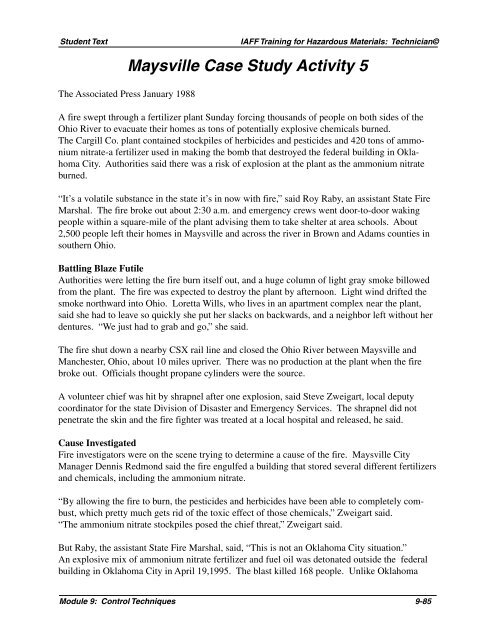Module 9: Control Techniques - International Association of Fire ...
Module 9: Control Techniques - International Association of Fire ...
Module 9: Control Techniques - International Association of Fire ...
You also want an ePaper? Increase the reach of your titles
YUMPU automatically turns print PDFs into web optimized ePapers that Google loves.
Student Text IAFF Training for Hazardous Materials: Technician©<br />
Maysville Case Study Activity 5<br />
The Associated Press January 1988<br />
A fire swept through a fertilizer plant Sunday forcing thousands <strong>of</strong> people on both sides <strong>of</strong> the<br />
Ohio River to evacuate their homes as tons <strong>of</strong> potentially explosive chemicals burned.<br />
The Cargill Co. plant contained stockpiles <strong>of</strong> herbicides and pesticides and 420 tons <strong>of</strong> ammonium<br />
nitrate-a fertilizer used in making the bomb that destroyed the federal building in Oklahoma<br />
City. Authorities said there was a risk <strong>of</strong> explosion at the plant as the ammonium nitrate<br />
burned.<br />
“It’s a volatile substance in the state it’s in now with fire,” said Roy Raby, an assistant State <strong>Fire</strong><br />
Marshal. The fire broke out about 2:30 a.m. and emergency crews went door-to-door waking<br />
people within a square-mile <strong>of</strong> the plant advising them to take shelter at area schools. About<br />
2,500 people left their homes in Maysville and across the river in Brown and Adams counties in<br />
southern Ohio.<br />
Battling Blaze Futile<br />
Authorities were letting the fire burn itself out, and a huge column <strong>of</strong> light gray smoke billowed<br />
from the plant. The fire was expected to destroy the plant by afternoon. Light wind drifted the<br />
smoke northward into Ohio. Loretta Wills, who lives in an apartment complex near the plant,<br />
said she had to leave so quickly she put her slacks on backwards, and a neighbor left without her<br />
dentures. “We just had to grab and go,” she said.<br />
The fire shut down a nearby CSX rail line and closed the Ohio River between Maysville and<br />
Manchester, Ohio, about 10 miles upriver. There was no production at the plant when the fire<br />
broke out. Officials thought propane cylinders were the source.<br />
A volunteer chief was hit by shrapnel after one explosion, said Steve Zweigart, local deputy<br />
coordinator for the state Division <strong>of</strong> Disaster and Emergency Services. The shrapnel did not<br />
penetrate the skin and the fire fighter was treated at a local hospital and released, he said.<br />
Cause Investigated<br />
<strong>Fire</strong> investigators were on the scene trying to determine a cause <strong>of</strong> the fire. Maysville City<br />
Manager Dennis Redmond said the fire engulfed a building that stored several different fertilizers<br />
and chemicals, including the ammonium nitrate.<br />
“By allowing the fire to burn, the pesticides and herbicides have been able to completely combust,<br />
which pretty much gets rid <strong>of</strong> the toxic effect <strong>of</strong> those chemicals,” Zweigart said.<br />
“The ammonium nitrate stockpiles posed the chief threat,” Zweigart said.<br />
But Raby, the assistant State <strong>Fire</strong> Marshal, said, “This is not an Oklahoma City situation.”<br />
An explosive mix <strong>of</strong> ammonium nitrate fertilizer and fuel oil was detonated outside the federal<br />
building in Oklahoma City in April 19,1995. The blast killed 168 people. Unlike Oklahoma<br />
<strong>Module</strong> 9: <strong>Control</strong> <strong>Techniques</strong> 9-85
















